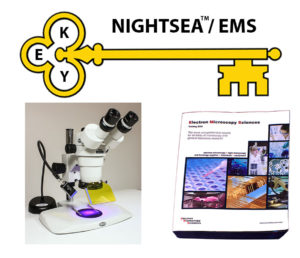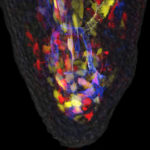KEY Award Recipient – 2019
Posted On: Thursday, August 22, 2019

The recipient of the fifth annual NIGHTSEA/EMS KEY Award for New Faculty (2019) is Dr. Joshua Currie, who started his new position as Assistant Professor in the Department of Cell & Systems Biology at University of Toronto in Canada. The KEY Award was instituted in 2015 by NIGHTSEA founder Dr. Charles Mazel to acknowledge his own mentors and as a way of giving back to the scientific community. The annual award, sponsored jointly by NIGHTSEA and Electron Microscopy Sciences (EMS), includes a NIGHTSEA Model SFA Stereo Microscope Fluorescence Adapter system outfitted with two excitation/emission combinations plus $750 in supplies from the EMS catalog.
Dr. Currie is researching the cellular and molecular basis of regeneration of complex tissues. Salamanders, including the Mexican axolotl, are able to regrow lost limbs and tails. The process is remarkably adaptable, producing just the right limb segments, perfectly scaled to the stump tissue regardless of the animal’s size or where an injury occurs. During his time as a research associate at TU Dresden in Germany (under the tutelage of Prof. Elly Tanaka) he was a key contributor to using live imaging of Brainbow transgenic axolotls to identify which connective tissues build the blastema for regeneration and the source zone from which they migrate. He documented distinct migratory and proliferative dynamics, discovered that the timing of dermal migration into the blastema biases contribution to skeleton of dermis, and that PDGF-BB is a connective tissue pro-migratory signal necessary for blastema formation. Dr. Currie’s goal is to use his pioneering method of using “Limbow” axolotls to image individual cells during the process of regeneration to understand how cells interpret molecular cues over space and time to regenerate the correct amount of tissue. His hope is to uncover the axolotls’ secrets, compare to what we learn in mammals’ incomplete wound repair and work towards improving therapies for human wound healing and regeneration.
- Dr. Joshua Currie
- A regenerating axolotl fingertip expressing a multi-color fluorescent transgene, Limbow
Dr. Currie’s new SFA system will provide him with the capacity for fluorescence screening of animals and embryos under a conventional stereo microscope right in his vivarium. He will also use it to perform grafting experiments of fluorescent tissue onto non-fluorescent hosts, as well as use it as a teaching tool for trainees. Josh appreciates the portability of the system for bringing fluorescence to schools and Science Street Festivals such as Science Rendezvous. The Limbow axolotls can fluoresce multiple colors, and having interchangeable wavelength sets of the NIGHTSEA SFA will be useful in working with the variety of fluorescing axolotl tissues.
The 2020 edition of the KEY Award will be announced in January.
Past recipients
- 2018 – Dr. Pierre-Paul Bitton (Memorial University of Newfoundland)
- 2017 – Dr. Kristen Gorman (California State University Chico)
- 2016 – Dr. Sarah Petersen (Kenyon College)
- 2015 – Dr. Robert Mitchell (University of Wisconsin Oshkosh)


